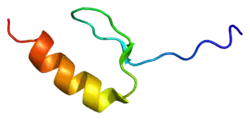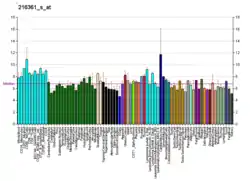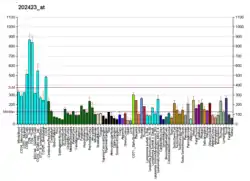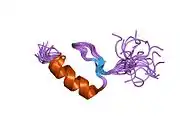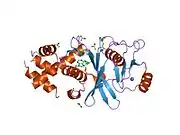KAT6A
K(lysine) acetyltransferase 6A (KAT6A), is an enzyme that, in humans, is encoded by the KAT6A gene.[5][6] This gene is located on the back wing of human chromosome 8, band 8p11.21. [7]
Function
KAT6A contains two nuclear localization domains, a C2HC3 zinc finger and an acetyltransferase domain. This structure suggests that KAT6A functions as a chromatin-bound acetyltransferase.[6] KAT6A is important for proper development of hematopoietic stem cells.[8]
Alternative names
- MYST3
- MOZ
- MRD32
- ZNF220
- RUNXBP2
- ZC2HC6A
References
- GRCh38: Ensembl release 89: ENSG00000083168 - Ensembl, May 2017
- GRCm38: Ensembl release 89: ENSMUSG00000031540 - Ensembl, May 2017
- "Human PubMed Reference:". National Center for Biotechnology Information, U.S. National Library of Medicine.
- "Mouse PubMed Reference:". National Center for Biotechnology Information, U.S. National Library of Medicine.
- "Entrez Gene: MYST3 MYST histone acetyltransferase (monocytic leukemia) 3".
- Borrow J, Stanton VP, Andresen JM, Becher R, Behm FG, Chaganti RS, Civin CI, Disteche C, Dubé I, Frischauf AM, Horsman D, Mitelman F, Volinia S, Watmore AE, Housman DE (September 1996). "The translocation t(8;16)(p11;p13) of acute myeloid leukaemia fuses a putative acetyltransferase to the CREB-binding protein". Nat. Genet. 14 (1): 33–41. doi:10.1038/ng0996-33. PMID 8782817. S2CID 205342752.
- - KAT6A NCBI
- Yang XJ, Ullah M (August 2007). "MOZ and MORF, two large MYSTic HATs in normal and cancer stem cells". Oncogene. 26 (37): 5408–19. doi:10.1038/sj.onc.1210609. PMID 17694082.
Further reading
- Schuler GD, Boguski MS, Stewart EA, et al. (1996). "A gene map of the human genome". Science. 274 (5287): 540–6. doi:10.1126/science.274.5287.540. PMID 8849440. S2CID 22619.
- Borrow J, Stanton VP, Andresen JM, et al. (1996). "The translocation t(8;16)(p11;p13) of acute myeloid leukaemia fuses a putative acetyltransferase to the CREB-binding protein". Nat. Genet. 14 (1): 33–41. doi:10.1038/ng0996-33. PMID 8782817. S2CID 205342752.
- Carapeti M, Aguiar RC, Goldman JM, Cross NC (1998). "A novel fusion between MOZ and the nuclear receptor coactivator TIF2 in acute myeloid leukemia". Blood. 91 (9): 3127–33. doi:10.1182/blood.V91.9.3127. PMID 9558366.
- Chaffanet M, Gressin L, Preudhomme C, et al. (2000). "MOZ is fused to p300 in an acute monocytic leukemia with t(8;22)". Genes Chromosomes Cancer. 28 (2): 138–44. doi:10.1002/(SICI)1098-2264(200006)28:2<138::AID-GCC2>3.0.CO;2-2. PMID 10824998.
- Champagne N, Pelletier N, Yang XJ (2001). "The monocytic leukemia zinc finger protein MOZ is a histone acetyltransferase". Oncogene. 20 (3): 404–9. doi:10.1038/sj.onc.1204114. PMID 11313971.
- Kitabayashi I, Aikawa Y, Nguyen LA, et al. (2002). "Activation of AML1-mediated transcription by MOZ and inhibition by the MOZ-CBP fusion protein". EMBO J. 20 (24): 7184–96. doi:10.1093/emboj/20.24.7184. PMC 125775. PMID 11742995.
- Pelletier N, Champagne N, Stifani S, Yang XJ (2002). "MOZ and MORF histone acetyltransferases interact with the Runt-domain transcription factor Runx2". Oncogene. 21 (17): 2729–40. doi:10.1038/sj.onc.1205367. PMID 11965546.
- Strausberg RL, Feingold EA, Grouse LH, et al. (2003). "Generation and initial analysis of more than 15,000 full-length human and mouse cDNA sequences". Proc. Natl. Acad. Sci. U.S.A. 99 (26): 16899–903. doi:10.1073/pnas.242603899. PMC 139241. PMID 12477932.
- Deguchi K, Ayton PM, Carapeti M, et al. (2003). "MOZ-TIF2-induced acute myeloid leukemia requires the MOZ nucleosome binding motif and TIF2-mediated recruitment of CBP". Cancer Cell. 3 (3): 259–71. doi:10.1016/S1535-6108(03)00051-5. PMID 12676584.
- Bristow CA, Shore P (2003). "Transcriptional regulation of the human MIP-1alpha promoter by RUNX1 and MOZ". Nucleic Acids Res. 31 (11): 2735–44. doi:10.1093/nar/gkg401. PMC 156734. PMID 12771199.
- Ota T, Suzuki Y, Nishikawa T, et al. (2004). "Complete sequencing and characterization of 21,243 full-length human cDNAs". Nat. Genet. 36 (1): 40–5. doi:10.1038/ng1285. PMID 14702039.
- Kindle KB, Troke PJ, Collins HM, et al. (2005). "MOZ-TIF2 inhibits transcription by nuclear receptors and p53 by impairment of CBP function". Mol. Cell. Biol. 25 (3): 988–1002. doi:10.1128/MCB.25.3.988-1002.2005. PMC 544007. PMID 15657427.
- Cereseto A, Manganaro L, Gutierrez MI, et al. (2005). "Acetylation of HIV-1 integrase by p300 regulates viral integration". EMBO J. 24 (17): 3070–81. doi:10.1038/sj.emboj.7600770. PMC 1201351. PMID 16096645.
- Kimura K, Wakamatsu A, Suzuki Y, et al. (2006). "Diversification of transcriptional modulation: large-scale identification and characterization of putative alternative promoters of human genes". Genome Res. 16 (1): 55–65. doi:10.1101/gr.4039406. PMC 1356129. PMID 16344560.
- Collins HM, Kindle KB, Matsuda S, et al. (2006). "MOZ-TIF2 alters cofactor recruitment and histone modification at the RARbeta2 promoter: differential effects of MOZ fusion proteins on CBP- and MOZ-dependent activators". J. Biol. Chem. 281 (25): 17124–33. doi:10.1074/jbc.M602633200. PMID 16613851.
- Lim J, Hao T, Shaw C, et al. (2006). "A protein-protein interaction network for human inherited ataxias and disorders of Purkinje cell degeneration". Cell. 125 (4): 801–14. doi:10.1016/j.cell.2006.03.032. PMID 16713569. S2CID 13709685.
- Kim SC, Sprung R, Chen Y, et al. (2006). "Substrate and functional diversity of lysine acetylation revealed by a proteomics survey". Mol. Cell. 23 (4): 607–18. doi:10.1016/j.molcel.2006.06.026. PMID 16916647.
- Olsen JV, Blagoev B, Gnad F, et al. (2006). "Global, in vivo, and site-specific phosphorylation dynamics in signaling networks". Cell. 127 (3): 635–48. doi:10.1016/j.cell.2006.09.026. PMID 17081983. S2CID 7827573.
- Topper M, Luo Y, Zhadina M, et al. (2007). "Posttranslational acetylation of the human immunodeficiency virus type 1 integrase carboxyl-terminal domain is dispensable for viral replication". J. Virol. 81 (6): 3012–7. doi:10.1128/JVI.02257-06. PMC 1865993. PMID 17182677.
This article is issued from Wikipedia. The text is licensed under Creative Commons - Attribution - Sharealike. Additional terms may apply for the media files.
